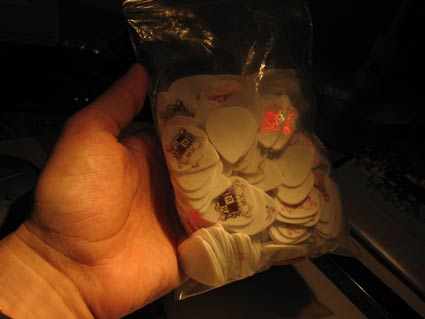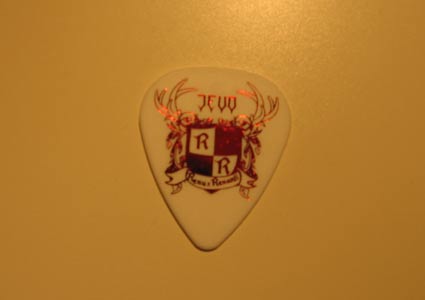Interesting - so the Paul Gilbert picks are smaller than the standard shape, Dean? Hard to tell from the pics...
Yeah it's smaller than those tear drop shaped picks.
My personal "pick-experiences" could get a bit in depth, redundant and OCD for you guys and most of it goes without saying.
My hypothesis:
What a pick is made of and how you use it is as important as the function of strings. How you hold/use the pick Is as crucial as where on a soccer ball you'd kick to curl it etc. Everything has a science. If you figure it out you can master it.
I needed a pick that could would feel comfortable (almost as comfortable as playing air guitar

).
The grip needed to be big enough to fit on my index finger. I think this is equivalent to car tires where with more surface area, the better the grip, the better the control. The smaller the pick, the more uncomfortable it is because it digs into your finger. Kind of like where standing on a bed of 1 000 nails is less painful than standing on a bed of 10.
A pick who's tip not only digs in well but has a side/edge that's angled well and scrapes off the strings evenly with not too much effort.
I'm sure it goes without saying, the scrape of the pick against new strings aids in getting crunch in your tone especially when you play low gain but still want a lot of crunch. When picks wear out, you lose that edge. That explained why bigger bands threw out picks.
And lastly one that responds well. What I mean by this is that has enough give/play when plucking that it returns to it's original state for the next note. Ergo the looser/thinner the pick, the longer it takes to return to it's flat state for the next plucked note. I like to think of this being similar to the function of a compressor where you have attack and release options. The faster the attack, the quicker it reacts etc.
It's why strumming is easier on bigger thinner picks as it has a longer release so that the next string gets a softer touch resulting in the chord sounding smoother.
Playing faster musical pieces required a plectrum that reacted faster. Kind of like drum pedals with tighter springs that returns the pedal to it's initial state as quick as possible for the next stroke resulting in faster playing.
My examination:
Jazz III's were the smallest so that meant it responded the fastest and allowed more control over faster picking. But the materials were a tad slippery which meant I had to scrape grooves in them with a blade (too much effort for a design "error" imo) to add more friction to the pick. It also covered less area on my index finger which meant my finger started to hurt easier because of the grip edge of the pick. I still can't put my finger on what the difference is, but the black ones were the best
Dunlop Tortex was my favorite for a while. I used the purple ones because I felt the
green was a bit flappier. It's
ever so slightly bigger and flatter than the Jazz III's which meant it was more comfortable due to more/simpler surface area.
It sounded GREAT because the tip and edge was close to perfect but I felt that it wore out too fast which bummed me out constantly. I'd always set aside the new ones for the shows/recording and the worn ones for practices.
Paul Gilbert signature pick imo is bigger than the tortex but not thinner/flappy. The surface is as flat as the Tortex which meant it was more comfortable and it didn't require any blade-grooves. It had an increased angle which means less work in digging in. The
blue pick is my preferred pick as it's thicker and allows for more precise picking than the
white one which is perfect for a softer touch. It did wear out quicker than the Jazz III's but longer than the Tortex.
The tip and edge was more sharper so it really brought out what I was picking making it more articulate. This also explains Paul Gilbert's outstanding articulation (next to his technique of course).
I plan on ordering a box of these soon.
I still want to check out the
Jazz III xl's and the ultex
Jazz III's.
 I got them when I started playing bass, but now I can't stand to use anything lighter on electric guitar. Usually using the .73s on acoustic
I got them when I started playing bass, but now I can't stand to use anything lighter on electric guitar. Usually using the .73s on acoustic











